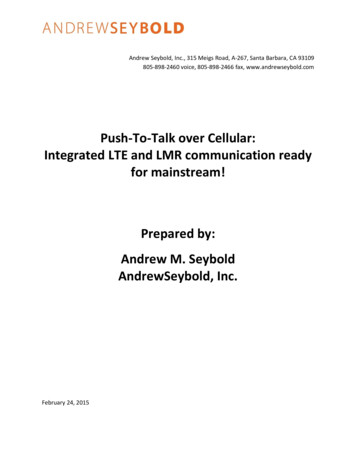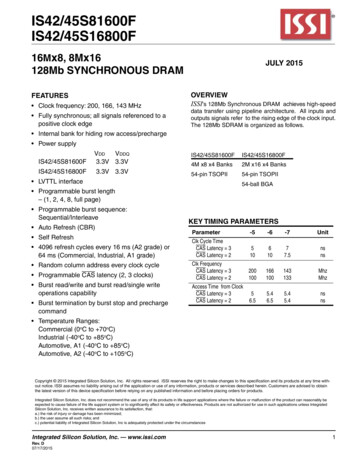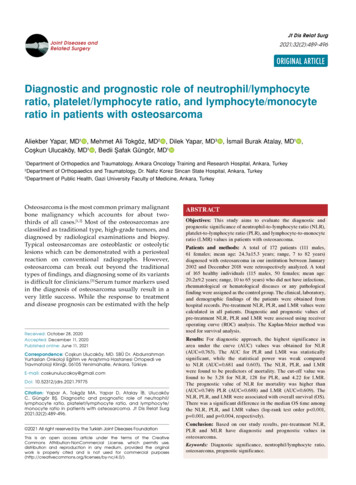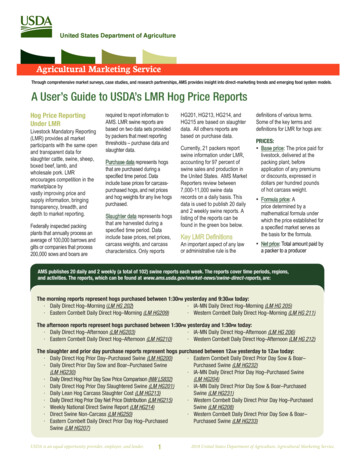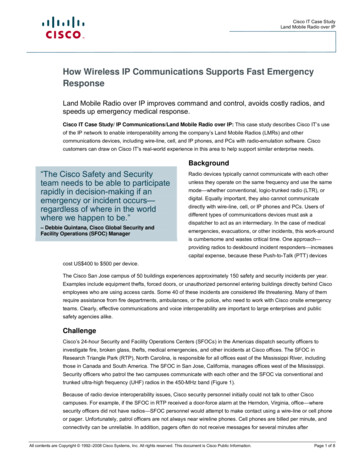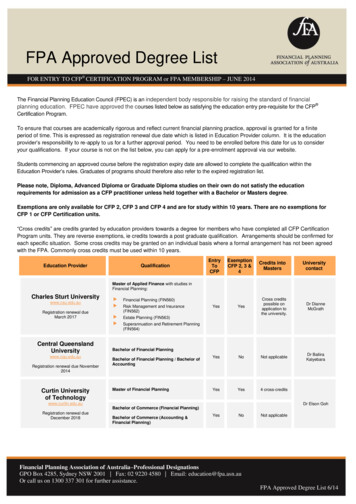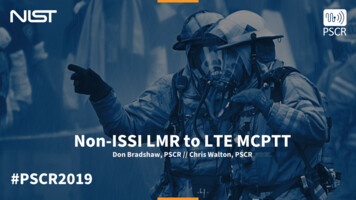
Transcription
Non-ISSI LMR to LTE MCPTTDon Bradshaw, PSCR // Chris Walton, PSCR#PSCR20191
DISCLAIMERCertain commercial entities, equipment, or materialsmay be identified in this document in order to describe anexperimental procedure or concept adequately.Such identification is not intended to implyrecommendation or endorsement by the NationalInstitute of Standards and Technology, nor is it intendedto imply that the entities, materials, or equipment arenecessarily the best available for the purpose.*Please note, unless mentioned in reference to a NISTPublication, all information and data presented ispreliminary/in-progress and subject to change2
Executive Summary Status of LMR to LTE Capabilities and Development The Missing Combination PSCR’s LMR to LTE Strategy Recognized Challenges Current Research Project Success3
Status of LMR to LTE Capabilities andDevelopment Inter-RF Subsystem Interface (ISSI) Designed for P25 to P25 System InteroperabilityFocus of Government and Industry for LMR to LTESolution for Compatible Systems (Newer P25)3GPP Interface Compliant Through Interworking Function (IWF)LMRBase StationISSIIWFMCPTTAppServerLTECore/RAN4
Status of LMR to LTE Capabilities andDevelopment Bridging System Interfaces (Radio Over IP ROIP ) Originally Designed for non-ISSI LMR Systems Requires Donor Radios or System Level Connection Proprietary Interfaces May Include 3GPP IWF (DHS Small Business Innovation Research) Core/RANProprietary5
Status of LMR to LTE Capabilities andDevelopment Custom Solutions LMR Infrastructure to LTE App Do Not Inherently Function on LTE DevicesProprietaryOTTAPPLMRBase taryMCPTTAppServerLTECore/RAN6
The Missing Combination Air-Interface (RF) Based Does Not Require Special Interface to Existing Systems Affordable No Donor Radios Required 3GPP Standards-Based Compatible with IWF and Mission Critical Push-to-Talk (MCPTT) Servers Does Not Require Middleware Service No Special Apps Open Source Competitive Environment for Companies7
PSCR’s LMR to LTE Strategy Overall Goal: Fill the Technology Gaps ISSI is Being Addressed by Industry ROIP and Other Custom Solutions Exist Timeframe Full LMR to LTE Effort Two to Three Years Current Project Six Months8
PSCR’s LMR to LTE Strategy Research Objectives Research and Prototype Software Defined Radio (SDR) Solutions “LTE core talks to the tower like it’s a radio” Focus on analog FM and non-ISSI compatible P25 Determine if Existing IWF and MCPTT Capabilities Are Sufficient Target Efforts to Fill Gaps 3GPP Standards Involvement and Contributions Position Industry to Benefit Public SafetyLMRRepeaterSDRIWFMCPTTAppServerLTECore/RAN9
Recognized Challenges Voice Encryption Security Usability Adoption of Products by Cellular Providers Adoption by 3GPP10
Current Research ProjectInnovative and affordable interworking of analog FM LMR radios in the LTE MCPTT worldChris Walton, PSCR
Current Research ProjectLMR to LTE Research Project Research the integration of analog FM LMR radios into a MCPTTsolution via 3GPP IWF. Leverage existing technologies for a highly standardizedsolution. Investigate using SDR (Software Defined Radios viaGNU Radio). Feedback to the standards bodies.12
Current Research ProjectRTP – Real Time Transport Protocol Paired with SIP and RTCP Transports digitized audio, video VOIP VoLTE MCPTTTarget ArchitectureSIP – Session Initiation Protocol Signaling protocol for session control Enables audio and video services VOIP VoLTE MCPTT13
Current Research ProjectCurrent MilestonesAccomplishments (to date) SDR development of an analog FMreceiver Implementation of basic audio andin-band signaling Ability to initiate SIP based VoIPcalls in a scripted testingenvironment Voice pass thru from the analogLMR to a LTE UENext Steps Development of a standardscompliant media plane control tohandle floor control across platforms Drive toward R16 IWF compliantsolution Research co-existence and/or14integration with ISSI
Current Research ProjectChallenges – Standards publication across various bodies LTE 3GPP – 3rd Generation Partnership Project P25 Stage 3 R16 work (Jun19) TIA – Telecommunications Industry Association ATIS – Alliance for Telecommunications Solutions Study on Interworking P25 LMR – MCPTT (Jun19) ETSI Base on R15 IWF ETSI – European Telecommunications Standards Institute TCCE (TETRA and Critical Communications Evolution) WG4 Complete work AFTER 3GPP R16 is published Will be used by TIA and 3GPP to update future standards15
Success Publicly Available Technology for Non-ISSI Legacy LMR to LTE Integration and Testing of a Prototype System Bridge PSCR LMR and LTE test beds Use of Open Source Software Solutions Low cost and enduring solution Use of Software Defined Radios No Donor Radios Technology and Path for Companies to Develop Products 3GPP Compliance and Support16
THANK YOU17
#PSCR2019Get your hands on the tech!DemosOpen8:00 AMBACK TOMORROW18
9 PSCR's LMR to LTE Strategy Research Objectives Research and Prototype Software Defined Radio (SDR) Solutions "LTE core talks to the tower like it's a radio" Focus on analog FM and non-ISSI compatible P25 Determine if Existing IWF and MCPTT Capabilities Are Sufficient Target Efforts to Fill Gaps 3GPP Standards Involvement and Contributions

